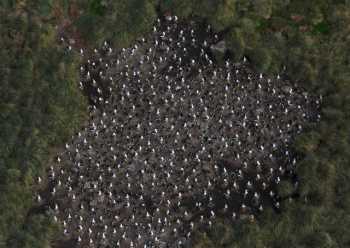The Black-browed Albatross Thalassarche melanophris is currently categorized as Endangered because its global population has been estimated to be decreasing in size at a rapid rate over three generations (65 years) on the basis of information from large breeding colonies in the south-west Atlantic, principally at the Falkland Islands(Islas Malvinas)* and South Georgia (Islas Georgia del Sur)*. These declines have been attributed to the impact of incidental mortality in longline and trawl fisheries, especially those operating in the South Atlantic.
Approximately 70% of the global population breeds in the Falkland Islands (Islas Malvinas)*, so the status of this population has a significant bearing on the global conservation status of the species.
Within the Falklands (Islas Malvinas)* aerial and ground-based surveys have been used independently to count the Black-browed Albatross population. Previously these census initiatives reported contrasting population trends. The aerial-based surveys indicated an increase in the population between 1986 and 2005 and the ground-based surveys a decline between 2000 and 2005, and using historical data an inferred decline between 1995 and 2005. The most recent archipelago-wide surveys of Black-browed Albatrosses breeding at the islands were conducted in 2010, five years after the previous census. In 2010, an aerial photographic survey of all colonies was conducted consistent with methods used in previous surveys (click here). Later in the same season an independent archipelago-wide survey was undertaken using the same ground-based methods employed in the 2000 and 2005 island-wide surveys.
Click here to access the final report of these latest surveys.

How many nesting Black-browed Albatrosses here?
Photograph by Ian Strange
Whereas there remain some discrepancies in the estimates derived from the different survey methods, the results from the 2010 aerial and ground surveys indicate that the population has increased over the last five years by a minimum of 4% a year. Both methods also show that the population in 2010 was larger than in 2000. Current estimates for the annual breeding population in the Falkland Islands (Islas Malvinas)* now range between 475 500 and 535 000 breeding pairs.
On the basis of these results the current conservation status of the Black-browed Albatross is likely more favourable than Endangered, suggesting it be down-listed (click here for more details of the process to be followed).
Anton Wolfaardt, ACAP Coordinator, Joint Nature Conservation Committee (JNCC), UK and John Cooper ACAP Information Officer, 29 July 2012
*A dispute exists between the Governments of Argentina and the United Kingdom of Great Britain and Northern Ireland concerning sovereignty over the Falkland Islands (Islas Malvinas), South Georgia and the South Sandwich Islands (Islas Georgias del Sur y Islas Sandwich del Sur) and the surrounding maritime areas.

 English
English  Français
Français  Español
Español